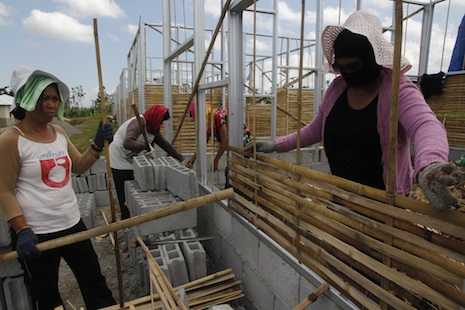
Typhoon survivors in Ormoc City build permanent homes for themselves with a grant from WeEffect, a Swedish development cooperation organization. (Photo by Jimmy A. Domingo)
Six months after Super Typhoon Haiyan devastated the central Philippines, thousands of families in the province of Leyte remain homeless and in desperate need of food and shelter, according to the UN and other aid agencies.
Edwin Torres, 32, has built a makeshift shelter on the same spot where his house stood before it was swept into the sea on November 8.
"I know that we are near the danger zone, but I have nowhere else to go," he said.
Pedro Cajipe, a father of four, said Typhoon Haiyan "took everything", adding that he has no money to purchase a new plot of land.
"I am more concerned about my children, especially my daughter. I don't feel safe here in the tent city," said Jenny Palahinog, who has to sleep with her four children inside a tent.
"We try our best to make it look like home," she said.
Tacloban Mayor Alfred Romualdez told ucanews.com that everything is "not yet normal" while the typhoon victims continue to live in tents and evacuation centers.
"The people need houses," he said in an interview.
He said at least US$12 million is needed to finance the urgent housing needs of about 10,000 families who are still living in the temporary shelters near the sea.
The city also needs some $16 million for the development of 90 hectares of land that will house around 9,000 families, Romualdez said. He said the national government has so far given the city $5 million for the repair of government infrastructure.
Mark Simbajon, convenor of survivors' group People Surge, said that although business establishments have reopened, "food security, economic stability, livelihood, and even basic housing and food supply are lacking."
Former senator Panfilo Lacson, who has been tasked by President Benigno Aquino to lead the rehabilitation efforts, admitted that "the challenge remains daunting" six months after the disaster.
He said some 182,843 housing units are "currently in the pipeline" with 14,873 units are under construction, while 130 units have been completed by private donors. Lacson, however, admitted that to date "there are only 26,155 generated lots against a total of 216,966 housing units" that have to be built.
Klaus Beck, United Nations Resident Humanitarian Coordinator, told ucanews.com that acquiring land for permanent resettlement "poses a big challenge" in the post-Haiyan recovery program, adding that this issue should be addressed by the local government immediately.
The United Nations Development Programme (UNDP) in a statement released today said that although there are physical signs of recovery, "much needs to be done."
UNDP Administrator Helen Clark said in the statement that full recovery needs a long term engagement from the international community.
"Recovery is about more than the vital task of building homes and structures. It is also about building greater resilience to natural hazards.”
Bernard Kerblat, UN High Commissioner for Refugees in the Philippines, said shelter and livelihood remained the "outstanding needs" of affected communities as the focus of humanitarian groups started to shift from relief towards recovery.
Dr Julie Hall, the World Health Organization country representative said in a statement: "We need clean and safe health facilities for the 70,000 births expected in the next three months as well as for those individuals who have ongoing health complications from diseases such as diabetes, cancer and tuberculosis.”
The WHO continues to map the state of repair and rebuilding of 582 public health facilities that were damaged or destroyed and to provide advice to ensure government and aid monies are directed to where the need is the greatest.
Last week, the Catholic Agency for Overseas Development, a Catholic aid agency in England and Wales, pledged to give $3.4 million to help victims of Haiyan.
Fr. Edu Gariguez, head of the social action secretariat of the Philippine bishops' conference, said he is also seeking the help of Caritas organizations to help rehabilitate dioceses affected by the typhoon.
Gariguez said some $14 million is needed to rehabilitate the nine dioceses most affected by Haiyan.
To date, UNHCR has already assisted over 600,000 people with specific needs by providing some 10,000 tents, 100,000 plastic sheets, 88,000 blankets, 14,000 kitchen sets, 33,000 jerry cans and 19,000 solar lanterns.
Super Typhoon Haiyan killed at least 6,000 people, with more that 2,000 others still missing, and displaced four million others from their homes.


